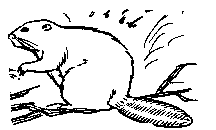CONCLUSIONS
Sensitive Areas We put in a 100-foot buffer along all of the streams in the sale area as well as a 100-foot buffer along the powerline. We left the areas in the upper northwest corner and the lower southeast corner or our sale area as a combination of wildlife reserve trees and riparian management zones.
Stand Conditions Table 1 is the results of the analysis for the design tree based upon the stand table generated in LMS. Table 1. Results of Stand Table for Design Payload. Tree species, Douglas fir was found to be the largest and most numerous species within the two stands. Average dbh and ht. were calculated including the standard deviation for the design payload.
Sale Boundaries The boundaries of the North Beacon sale, located in Township 24/25 N, Range 3 W, were given to us by the DNR. However, these boundaries were modified by the 100-foot stream buffers around the type 4 and type 5 streams as well as the wildlife reserve trees area in the northwest and south east corners. Also, we put in a 100-foot buffer around the power line in the eastern section of the sale area.
Costing We performed a cost analysis using the program, WFI Logging Cost Estimates. Table 2 sums up the results of the costing analysis.
Table 2. Harvesting cost breakdown by type of yarding system. Cost/Volume assumes a large tower yarder, where applicable. Timber Volume estimates are from the stand data information.
Logging We performed a payload analysis using the program, LoggerPC version 3.2. Table 3 sums up the results of the payload analysis for each spoke of each landing (2-6 represents landing 2, spoke 6).
Table 3. Results of Payload Analysis
The rest of the sale area (minus the buffer zones and leave trees) will be shovel yarded.
Production The production times were calculated using the following equation: TT (min.) = 0.003234(SYDIST) + 0.021212(SLOPE) + 0.018860(LDIST) + 0.206100(LOGS) + 0.000190(BFVOL) + 0.000241(WEIGHT)
Table 4 . Production times for each landing and the overall setting based on the equation above.
| |||||||||||||||||||||||||||||||||||||||||||||||||||||||||||||||||||||||||||||||||||||||||||||||||||||||||||||||||||||||||||||||||||||||||||||||||||||||||||||||||||||||||||||||||||||||||||||||||||||||||||||||||||||||||||||||||||
